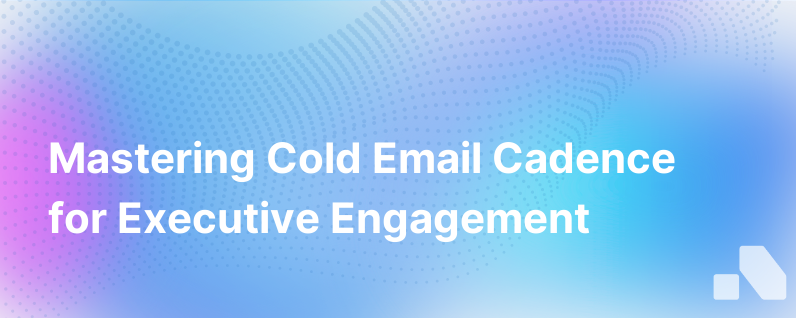
Creating a cold email cadence design that achieves peak performance—it's the stuff of countless discussions in sales and marketing departments around the world. After all, cold emailing remains a vital tool in the acquisition toolbox, offering both scale and cost-effectiveness. But its success lies in the delicate balance of art and science: hitting the right notes at the right times to gently guide a prospect from unawareness to curiosity and finally to taking action.
To reach that zenith where cold emailing becomes a connective art form rather than a blunt instrument, we need to dive deep into the methodology that has proven its merit across diverse industries and market segments.
What is a Cold Email Cadence?
Simply put, a cold email cadence is a structured sequence of outreach efforts, where each email is timed and crafted to earn a response from potential customers who have had no prior contact with your business. A well-thought-out cadence is about intentionality—it's a purposeful dance with rhythm and grace, inviting prospects to join in.
The Anatomy of an Effective Cadence
At its core, an effective cold email cadence is about three things: timing, personalization, and value addition. Each email should be delivered at a point where the recipient is most likely to engage, with content honed to their specific needs and pain points and providing undeniable value that gets them to pay attention and react.
To craft such a cadence, follow these detailed steps:
1. Understand Your Audience
The first step in cold email campaigning is understanding who you're talking to. What are their pain points? What times are they most active in their business communication? Use tools, research, or even surveys to gather information about your target personas. This data will be the backbone of your emails' tonality, content, and timing.
2. Define Your Value Proposition
Clearly articulate what you offer and why it's unique. It should be the sharpened tip of your spear—penetrating through the inbox clutter to capture attention. Every email should reinforce your value proposition in various creative ways without being repetitive.
3. Craft the Opening Email
Your opening email is your first impression, and it needs to count. Aim for brevity and clarity. Introduce yourself, mention how you found them (if it's relevant and likely to warm them to your message), and succinctly illustrate the value you're offering. Avoid giving too much away; the goal is to incite enough interest for them to engage.
4. Sequence and Timing
The sequence and timing of follow-up emails are pivotal. Here's an example of a typical cadence structure:
- Day 1: First contact
- Day 3: Follow-up if no response (add more value or context)
- Day 7: A different angle or a new piece of information
- Day 14: Light follow-up, acknowledge their busy schedule
- Day 21: A soft break-up email
Tweak these intervals based on the responses and engagement levels you monitor.
5. Personalization
Everyone knows when they've received a mass email—it's the one that speaks to no one in particular. Personalization goes beyond “Hi [Name].” Use the intelligence gathered to tailor your message to their business, their role, and their current challenges.
6. Content that resonates
If your prospect doesn't see immediate value or relevance, your email is likely to be discarded. Use bullet points or concise paragraphs to get your point across. Visual content, like infographics or short videos, can also break the monotony of text.
7. Subject Lines and Opening Hooks
Your subject line is the gatekeeper. It should be compelling enough to earn an open. Once opened, the first line must continue the momentum. Engage them with a question, a startling stat, or a bold statement that relates directly to their situation.
8. Call-to-Action (CTA)
Be clear on what you want them to do next. Is it a phone call, a demo, or just a simple reply? Make the next steps easy and frictionless.
9. Analysis and Optimization
Track metrics like open rates, click-through rates, and response rates. Analyze and iterate. Notice patterns—do certain subject lines work better? Are there better times to send emails?
10. Incorporate Breaks and Breathers
Space is as important in music as it is in email cadences. Don't be afraid to introduce pauses in your sequences—giving your prospect time to digest information and take action.
11. Respectful Persistence
Not every prospect is ready to engage immediately. But a well-timed, respectful nudge can work wonders. That said, know when to walk away. Once you've cycled through your cadence, and it's clear there's no interest, move on.
Conclusion
A well-planned cold email cadence aligns with the natural communication flow and gradually builds up a story that wraps your value offering in an irresistible narrative. It can transform cold contacts into warm leads and, ultimately, into valuable customers.
When crafting your cold email cadence keep it relevant, useful, and engaging. And remember, this isn't a 'set it and forget it' affair. Continuous learning and refinement will keep your cadence in rhythm with the ever-evolving dance of buyer's behaviors.
At Aomni, we understand that the intricacies of account research, competitive insights, and personalized content creation are demanding on time. With our platform's ability to deliver these elements in a matter of minutes and with zero effort, you can focus on fine-tuning your cold email cadences to perfection.